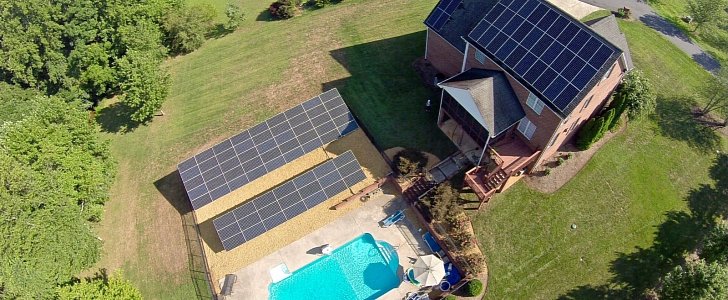Electric cars often get slammed for the fact that despite having zero tailpipe emissions (thoroughly helped by the fact they have no tailpipe), the electric power used to charge their batteries came from fossil-fuel burning power plants.
In essence, that means that all these vehicles do is move the pollution from the streets to wherever it is these plants are located. One of the dreams of anyone owning such vehicles is to be able to produce their own clean electric power. Not only would they shut the mouths of all detractors, but it would also mean free motoring for them.
Well, it looks like Jason Hughes is living the dream. Well, 98.4 percent of it, at least. He is the guy that first found out about the P100D model a full six months before the official unveil took place. We've also featured another project of his where he's trying to build a 1,000 hp electric monster by basically removing the smaller front motor of a four-wheel-drive Tesla chassis and replacing it with one identical to the one powering the rear axle.
His latest finding came only a few days ago while he was browsing through the Media Center Unit of a scrapped Model S. It turns out that the Autopilot's cameras do store some images similar to how a dashcam would, only they are black and white and shot at greater intervals. Still, as the donor car in this case proved, it's enough to elucidate what it was that sent that particular vehicle to the crusher.
You'll notice that Jason deals with a lot of broken down Teslas. If that was largely a mystery up until now, he has now revealed the main reason behind it: he was building a home battery storage unit to take advantage of the 103 commercial-grade solar panels installed on his property. The build was completed one year ago, so 366 days later (it was a leap year) it was time for an evaluation.
According to the data he published on his website, the battery cells that came from 2.25 Tesla Model S 85kWh packs helped keep his household 98.4 percent off-the-grid. This is even more impressive considering everything in the house is electric - heating, cooling, cooking - and he and his wife both drive Teslas. Here are a few more technical details Jason revealed about this past year.
- 43,929 kWh generated by solar array and utilized (Average 120
- kWh/day, usable AC power)
- 20,576 kWh discharged from the batteries
- 114 equivalent cycles on the storage batteries
- 11,259 kWh used for Tesla Model S charging (over 33,000 miles)
- Best production day: 2016-03-21 @ 260.7 kWh (Charged three Model S that day)
- Worst production day: 2016-01-22 @ 0.02 kWh (All panels covered in several inches of snow)
- On 222 out of 366 days (60.7%) the storage batteries reached full capacity before sunset and some amount of incoming power was wasted.
Well, it looks like Jason Hughes is living the dream. Well, 98.4 percent of it, at least. He is the guy that first found out about the P100D model a full six months before the official unveil took place. We've also featured another project of his where he's trying to build a 1,000 hp electric monster by basically removing the smaller front motor of a four-wheel-drive Tesla chassis and replacing it with one identical to the one powering the rear axle.
His latest finding came only a few days ago while he was browsing through the Media Center Unit of a scrapped Model S. It turns out that the Autopilot's cameras do store some images similar to how a dashcam would, only they are black and white and shot at greater intervals. Still, as the donor car in this case proved, it's enough to elucidate what it was that sent that particular vehicle to the crusher.
You'll notice that Jason deals with a lot of broken down Teslas. If that was largely a mystery up until now, he has now revealed the main reason behind it: he was building a home battery storage unit to take advantage of the 103 commercial-grade solar panels installed on his property. The build was completed one year ago, so 366 days later (it was a leap year) it was time for an evaluation.
According to the data he published on his website, the battery cells that came from 2.25 Tesla Model S 85kWh packs helped keep his household 98.4 percent off-the-grid. This is even more impressive considering everything in the house is electric - heating, cooling, cooking - and he and his wife both drive Teslas. Here are a few more technical details Jason revealed about this past year.
- 43,929 kWh generated by solar array and utilized (Average 120
- kWh/day, usable AC power)
- 20,576 kWh discharged from the batteries
- 114 equivalent cycles on the storage batteries
- 11,259 kWh used for Tesla Model S charging (over 33,000 miles)
- Best production day: 2016-03-21 @ 260.7 kWh (Charged three Model S that day)
- Worst production day: 2016-01-22 @ 0.02 kWh (All panels covered in several inches of snow)
- On 222 out of 366 days (60.7%) the storage batteries reached full capacity before sunset and some amount of incoming power was wasted.

